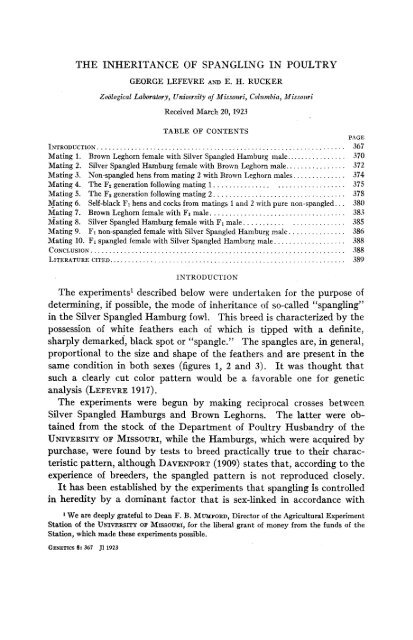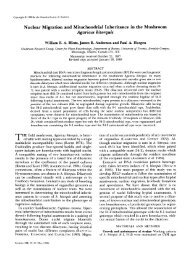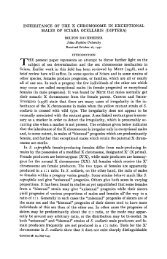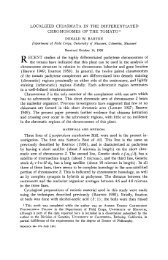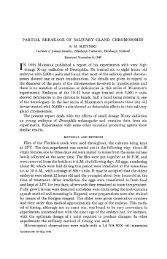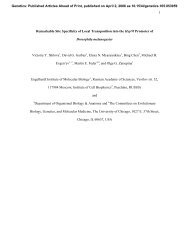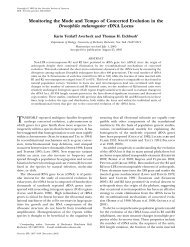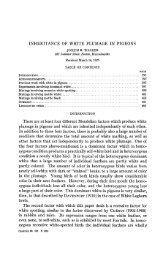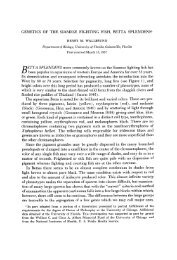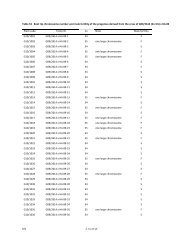THE INHERITANCE OF SPANGLING IN POULTRY The ... - Genetics
THE INHERITANCE OF SPANGLING IN POULTRY The ... - Genetics
THE INHERITANCE OF SPANGLING IN POULTRY The ... - Genetics
Create successful ePaper yourself
Turn your PDF publications into a flip-book with our unique Google optimized e-Paper software.
<strong>THE</strong> <strong><strong>IN</strong>HERITANCE</strong> <strong>OF</strong> <strong>SPANGL<strong>IN</strong>G</strong> <strong>IN</strong> <strong>POULTRY</strong><br />
GEORGE LEFEVRE AND E. H. RUCKER<br />
Zoological Laboratory, University of Missoawi, Cohmbia, Missouri<br />
Received March 20, 1923<br />
TABLE <strong>OF</strong> CONTENTS<br />
<strong>IN</strong>TRODUCTIOX. ................................................................. 367<br />
Mating 1. Brown Leghorn female with Silver Spangled Hamburg male.. .............. 370<br />
Mating 2. Silver Spangled Hamburg female with Brown Leghorn male.. .............. 372<br />
Mating 3. Non-spangled hens from mating 2 with Brown Leghorn males. ............. 374<br />
Mating 4. <strong>The</strong> F2 generation following mating 1. ................................ 375<br />
Mating 5. <strong>The</strong> F2 generation following mating 2. .................................. 378<br />
Mating 6. Self-black F1 hens and cocks from matings 1 and 2 with pure non-spangled ... 380<br />
Mating 7. Brown Leghorn female with F1 male. ................................... 383<br />
Mating 8. Silver Spangled Hamburg female with F1 male. ........................ 385<br />
Mating 9. F1 non-spangled female with Silver Spangled Hamburg male. .............. 386<br />
Mating 10. F1 spangled female with Silver Spangled Hamburg male. .................. 388<br />
CONCLUSION. ................................................................... 388<br />
PAGE<br />
LITERATURE CITED.. ............................................................. 389<br />
<strong>IN</strong>TRODUCTION<br />
<strong>The</strong> experiments1 described below were undertaken for the purpose of<br />
determining, if possible, the mode of inheritance of so-called “spangling”<br />
in the Silver Spangled Hamburg fowl. This breed is characterized by the<br />
possession of white feathers each of which is tipped with a definite,<br />
sharply demarked, black spot or “spangle.” <strong>The</strong> spangles are, in general,<br />
proportional to the size and shape of the feathers and are prese1;t in the<br />
same condition in both sexes (figures l., 2 and 3). It was thought that<br />
such a clearly cut color pattern would be a favorable one for genetic<br />
analysis (LEFEVRE 19 17).<br />
<strong>The</strong> experiments were begun by making reciprocal crosses between<br />
Silver Spangled Hamburgs and Brown Leghorns, <strong>The</strong> latter were obtained<br />
from the stock of the Department of Poultry Husbandry of the<br />
UNIVERSITY <strong>OF</strong> MISSOURI, while the Hamburgs, which were acquired by<br />
purchase, were found by tests to breed practically true to their characteristic<br />
pattern, although DAVENPORT (1909) states that, according to the<br />
experience of breeders, the spangled pattern is not reproduced closely.<br />
It has been established by the experiments that spangling is controlled<br />
in heredity by a dominant factor that is sex-linked in accordance with<br />
We are deeply grateful to Dean F. B. MUMFORD, Director of the Agricultural Experiment<br />
Station of the UNIVERSITY <strong>OF</strong> MISSOURI, for the liberal grant of money from the funds of the<br />
Station, which made these experiments possible.<br />
GENETICS 8: 367 J1 1923
368<br />
I<br />
t<br />
FIC.~-RI: 1 .-Silvcr Spnnglcd Hamburg male.<br />
FIGURE 2.--Silver Spangled Hamburg female.
thc mode of sex-linkage that is typical of poultry. In the males, therefore,<br />
the sex chromosomes may be represented in the conventional manner by<br />
ZZ, in the female, by ZW.<br />
It has been shown, furthermore, that the expression of spangling may<br />
be greatly modified, or even entirely obscured, by the presence of other<br />
factors, especially of factors for black pigmentation, which, however,<br />
segregate independently of the factor for spangling and are, therefore,<br />
autosomal. <strong>The</strong>se disturbing factors may affect the entire body or only<br />
I:IG~.RE 3.-Comparison of spangles on tips of corresponding feathers in the Silver Spangled<br />
I-Ianlhurg, upper row, and in an individual derived from crossing, in which the spangles are greatly<br />
reduced in size, lower row. A, hackle; B, saddle; C, sickles; D, secondaries; E, wing-coverts;<br />
F. breast.<br />
some restricted region, like the feathers of the tail. Black pigment may<br />
also be present on individual feathers in other places than at the tip, and,<br />
in varying degrees, obscure the definiteness of the spangles. In fact, a<br />
maximum condition of melanism is sometimes reached, in which black is<br />
present to such an extent that the bird becomes self-colored and is practically<br />
black all over. In these cases, spangling is of course entirely masked,<br />
and the presence of the factor for spangling can only be recognized by<br />
making the appropriate breeding tests which demonstrate that these<br />
birds transmit spangling without showing it themselves.<br />
GESETICS 8: ]l 1923
3 70 GEORGE LEFEVRE AND E. H. RUCKER<br />
It has also been observed that the opposite condition may exist, and<br />
that, owing to factors that apparently influence the size of the spangles,<br />
the white of the feathers may extend farther toward the tip, thus confining<br />
the spangle to a much smaller area. <strong>The</strong> amount of the area covered<br />
by the spangle varies in different individuals, and in some birds the<br />
spangle may become so restricted as to appear merely as an attenuated<br />
spot, much smaller than the corresponding spangle of the pure Hamburg,<br />
or it may be greatly diminished in intensity (figure 3). Just as the<br />
presence of black factors may lead to a cumulative effect and thereby<br />
cause a varying degree of extension of the pigmentation, it is also true that<br />
the restriction of the spangles appears to<br />
degrees of attenuation are seen.<br />
be cumulative, as different<br />
It should also be mentioned that, although the ground color of the<br />
feathers is usually white when spangling is present, it may be replaced by<br />
golden bay, a condition seen in the Golden Spangled Hamburgs of the<br />
poultry fancier, which, however, is recessive to white and appears only<br />
after segregation of the factors concerned in the Fz generation and later.<br />
A detailed account of the more important matings that have been made<br />
and an analysis of the results follow.<br />
MAT<strong>IN</strong>G 1. BROWN LEGHORN FEMALE WITH SILVER SPANGLED HAMBURG MALE<br />
In the progeny of this mating, spangling appears in both sexes. <strong>The</strong><br />
cocks show the spangles in a fairly typical fashion throughout the body,<br />
except that their tails are glossy black (figure 4). <strong>The</strong> hens are also<br />
spangled and have black tails, but, owing to the presence of more or less<br />
black on other parts of the feathers as well as at the tips, the spangling<br />
is somewhat obscured. <strong>The</strong> spangles of the hens are most definite on<br />
the neck, back, breast, wing-coverts and secondaries. Figure 5 is a hen<br />
from this mating, and although the spangles may be seen distinctly,<br />
especially on the neck, breast and wings, a comparison with the cocks<br />
shows that the condition is less characteristic of typical spangling.<br />
In addition to these spangled cocks and hens, one male and two females<br />
were obtained from the cross that were almost black throughout. <strong>The</strong>ir<br />
presence in the brood was at first regarded as inconsistent with the as-<br />
sumption, otherwise borne out, of sex-linkage, but it was later discovered<br />
that these black birds, although completely masked by black, trans-<br />
mitted spangling in exactly the same way as did their spangled brothers<br />
and sisters. <strong>The</strong>y would, therefore, seem to be best explained by as-<br />
suming the presence of multiple factors for black which, after segregation
<strong>IN</strong>HERIT.4NCE <strong>OF</strong> SPANGLIhTG I S <strong>POULTRY</strong> 371<br />
in gametogenesis, have a cumulative effect and produce in a minority of<br />
cases birds of both sexes that are practically self-colored.<br />
<strong>The</strong> mating yielded 22 spangled birds and 3 blacks, a ratio of about<br />
7 to 1.<br />
yX7-2 .. '.p-<br />
". . " " .~<br />
FIGGRE 4."1:1 male from cross betlveen Brown 1,t~horn hrn anti Silver Spangled Hamburg<br />
cock (mating 1 ).<br />
<strong>The</strong> black cock from this cross - .<br />
is shown in figure 6, and the proof<br />
of his ability, as well as of that of<br />
the black hens, to transmit spang-<br />
ling is presented in mating 6.<br />
As will be' indicated below,<br />
similar black birds were obtained<br />
from the reciprocal cross and from<br />
other matings in which only<br />
spangled individuals of either one<br />
or both sexes were expected, but<br />
their occurrence in all such cases<br />
may be accounted for on the<br />
same assumption of multiple<br />
factors for black.<br />
FIGURE ~.--I.'I female from cross between<br />
<strong>The</strong> results of matings meet Brown Leghorn hen and Silver Spangled Ham-<br />
with a consistent interpretation on burg cock (mating 1).<br />
GENETICS X: JI 192.1
372 GEORGE LEFI~YRE ASD I-. H. RUCKEH<br />
the basis of the sex-linkage of a factor for spangling, and, as in all cases<br />
of the same kind that have been recorded for poultry, the males may be<br />
represented by the formula ZZ, the females by ZW.<br />
<strong>The</strong> analysis of the results of mating 1 is as follows:<br />
Males 1:cmolcs<br />
Parents ZSZ" PW<br />
Gametes zs, zs %S, 11:<br />
F, ZSZS %"\;I:<br />
<strong>The</strong> exponents in the above formulae stand for the sex-linked factors<br />
involved? namely, S for spangled, S for non-spangled.<br />
I.'IGURE 6.-F1 black cock from cross between Brown Leghorn female and Silver Spannletl<br />
Hamburg male, showing full effect oi multiple factors for black (mating 1).<br />
<strong>The</strong> other factors disclosed by the cross need not be here considered.<br />
Obviously, there is a dominant black-tail factor received from the Leghorn<br />
mother by both sons and daughters, and in a small percentage of the<br />
F1 birds a masking effect of black is seen in the three wholly black individuals<br />
already referred to.<br />
MATISG 2. SILVER SPANGLED HAMBURG FEMALE WITH BROWN<br />
LEGHORN MALE<br />
This is the reciprocal cross of the preceding, and, on the assumption<br />
of the sex-linkage of the spangling factor, spangled cocks and non-
ISHERIT.\SCE <strong>OF</strong> SP.\SGLISG I S <strong>POULTRY</strong> 373<br />
spangled hens should be expected. Such was the case. Nineteen spangled<br />
cocks with black tails (figure 7), identical in appearance with the cocks from<br />
mating 1. mere obtained, and<br />
three black cocks exactly like the<br />
black male (figure 6) from the<br />
reciprocal cross also appeared in<br />
the brood, the ratio being prac-<br />
tically the same as after the<br />
former mating, or about 7 to 1.<br />
<strong>The</strong> hens, on the other hand,<br />
were without exception non-<br />
spangled (figure s), being almost<br />
self-black, with a little golden<br />
brown lacing on the neck.<br />
In the progeny of this cross,<br />
we see the typical condition of<br />
sex-linkage, since the spangling,<br />
when introduced by the female,<br />
appears only in the sons, as<br />
contrasted with its occurrence<br />
in both sons and daughters,<br />
when the father is spangled, as<br />
in mating 1.<br />
<strong>The</strong> three black cocks are<br />
only an apparent exception, for<br />
it has been shown by testing<br />
them that they, like the black<br />
male from the reciprocal cross,<br />
transmit spangling in exactly<br />
the same way as do their<br />
spangled brothers. In other<br />
words, they are heterozygous<br />
for the spangling factor, but<br />
they themselves fail to show<br />
spangles, as they are masked<br />
by black throughout.<br />
<strong>The</strong> analysis of the results of<br />
mating 2 is as follows:<br />
M der Females<br />
Parents ZrZr z: w<br />
Gametes zs, zr zs, w<br />
FIGURE 8.-Ft female (non-spangled) from<br />
cross between Silver Spangled Hamburg hen and<br />
F1 2' zs zr w Brown Leehorn cock (mating 2).<br />
CEWTICS 8: Jl 1923<br />
FIGURE<br />
7.-1:1 male from cross between Silver<br />
Spangled Hamhurfi hen and Rro\vn Leghorn cock<br />
(mating2).
374 GEOKGII LEFEVRE AND E. H. RUCKEK<br />
MAT<strong>IN</strong>G 3. NON-SPANGLED HENS FROM MAT<strong>IN</strong>G 2 WITH BROWK<br />
LEGHORN MALES<br />
It was necessary, in order to prove the sex-linkage of the spangling<br />
factor, to show that the non-spangled hens obtained from mating 2<br />
were not only non-spangled in appearance, but that the spangling factor<br />
was not received by them and, therefore, could not be transmitted by<br />
them. Such a test could be made by mating them to non-spangled cocks,<br />
and this was done by breeding several of the hens with pure Brown Leg-<br />
horn males. Although a large number of birds were obtained from the<br />
cross, in not a single instance was there the slightest indication of spang-<br />
. . "".<br />
I.<br />
FIGURES 9 and lO.--I'rogeny of F I non-spangled hen and Brown Leghorn cock (mating 3).<br />
ling in the offspring. <strong>The</strong> latter were without exception black with more<br />
or less red and yellow streaking. A male and a female from this mating<br />
are seen in figures 9 and 10, respectively, in which no trace of spangling<br />
is in evidence.<br />
It may, therefore, be concluded that the non-spangled hens of the F1<br />
generation do not carry a factor for spangling.<br />
<strong>The</strong> analysis is as follows:<br />
Males Pentalcs<br />
Parents Z' Z' Z'W<br />
Gametes Z', z5 zs l \j,r<br />
Offspring Z'Z' Z'M.
<strong><strong>IN</strong>HERITANCE</strong> <strong>OF</strong> SPANGLIXG IS <strong>POULTRY</strong> 375<br />
MAT<strong>IN</strong>G 4. <strong>THE</strong> F2 GENERATION FOLLOW<strong>IN</strong>G MAT<strong>IN</strong>G 1<br />
In order to further demonstrate the sex-linkage of the factor for spang-<br />
ling, matings were made for the purpose of contrasting the results in the<br />
Fz generations derived from the two original crosses, respectively.<br />
It has been seen that in mating 1 spangling appears in both sexes.<br />
<strong>The</strong>se spangled F, cocks and hens were accordingly mated with the<br />
expectation that they would produce only spangled sons and that fifty<br />
percent of the daughters would be spangled and fifty percent would be<br />
non-spangled. <strong>The</strong> actual results conformed perfectly to the prediction.<br />
Twelve males were obtained, all of which were spangled except one which<br />
FIGURE ll.--Cork<br />
male (mating 4).<br />
o f l:? xcnrration aitvr cros Iwtwcn Lcchorn fcmnlc antl Ilamburg<br />
was identical in appearance with the black cocks from matings 1 and 2<br />
(figure 6) antl which again can be accounted for on the assumption of an<br />
accumulation of multiple factors for black. Unfortunately, this bird<br />
died before it was possible to test him. A majority of the males had black<br />
tails and were exactly like the F1 cocks. Figure 11 shows such a male.<br />
Owing, however, to independent segregation antl recombination of<br />
factors for black and for white, the F2 cocks exhibited different degrees of<br />
the extension of black and white on the feathers. Contrast the male of<br />
figure 11 with the one shown in figure 12, which is from the same mating,<br />
but which has an excess of black pigment, especially on the under parts,<br />
more or less obscuring the spangles. As an illustration of a bird in which<br />
the white is extended, observe the condition of the cock seen in figure 13,<br />
GEKETICS 8: JI 1929
376<br />
1 7 ~ ~ r - ~ ~<br />
I3.-Cock from mating 4, showing reduction of spangles both in size and bril-<br />
liancy. Some of the spangles are mere shadow and are almost invisible in the photograph.
IXHERIT.4NCE <strong>OF</strong> SP"WC1,ISG IK <strong>POULTRY</strong> 37i<br />
also from this mating, in which the spangles are much reduced both in<br />
size and brilliancy and in some cases appear almost like shadows.<br />
<strong>The</strong> hens, on the other hand, were of both types, spangled and non-<br />
spangled, eight of each having been obtained from the mating, in exact<br />
FIGURE 14.--Spangled hen of F? generation after cross between Leghorn female and Hamburg<br />
male (mating 4).<br />
FIGURE 15.-Xon-spangled F2 hen after cross Ixtween Leghorn female and I-Iamburg male<br />
(mating 4).<br />
accordance with the theoretical ratio. As in the case of the males, the<br />
spangled hens showed different degrees of the extension of black and<br />
GENETIC$ 8: ]I 1923
3 78 GEORGE LEFEVKE ASD E. H. RUCKER<br />
white. In figure 14, is seen one of the spangled hens, showing some excess<br />
of white, especially on the wings, while figure 15 is one of the non-spangled<br />
hens from the mating. <strong>The</strong> latter has the characteristic coloring of the<br />
Brown Leghorn which was also present in one of the other hens.<br />
It should also be mentioned that the recessive golden bay ground-color<br />
replaced the white in two of the spangled birds from this mating.<br />
<strong>The</strong> analysis of the mating is as follows:<br />
ffalcs Fcmalcs<br />
Parents ZSZS zsw<br />
Gametes P , z' zs, W<br />
Off spring yzs, z.Yzs z"w, zsw<br />
FIGURES 16 and 17.-F* spangled and non-spangled cocks after cross between Hamburg<br />
female and Leghorn male (mating 5).<br />
MAT<strong>IN</strong>G 5. <strong>THE</strong> F2 GENERATION FOLLOW<strong>IN</strong>G MAT<strong>IN</strong>G 2<br />
It is of interest to compare with the foregoing the F2 generation from<br />
the original cross between the Brown Leghorn cock and the Silver<br />
Spangled Hamburg hen. Here the expectation is that both spangled and<br />
non-spangled birds should appear in equal numbers in each sex, whereas,<br />
as has been seen, the F2 generation from the reciprocal cross lacked non-<br />
spangled males.<br />
<strong>The</strong> mating yielded spangled and non-spangled cocks and hens in ap-<br />
proximately equal numbers. <strong>The</strong> four types of birds are shown in figures<br />
16 to 19.
ISHERITANCE <strong>OF</strong> SP.\?\TGL<strong>IN</strong>G IS <strong>POULTRY</strong> 379<br />
Varying degrees of an excess of black and of white were observed, as<br />
in mating 4, and one male was produced with the spangles on a golden<br />
bay ground (figure 20).<br />
FIG= 18 and 15.”r* span;led and non-spangled hens aftcr cross between Hamburg<br />
female and Leghorn male (mating 5).<br />
<strong>The</strong> analysis follows : Mdes Females<br />
Parents ZSZ’ Z’ W<br />
Gametes zs, zs z’, W<br />
Offspring ‘ ZSZ‘, Z’Z’ zsw, Z‘W<br />
GENETICS 8: J1 1923
MAT<strong>IN</strong>G 6. SELF-RLACK F1 HENS AND COCKS FROM MATIKGS 1 AND 2 WITH<br />
PURE XON-SPANGLED<br />
It has yet to be shown that the self-black birds, appearing in the F1<br />
generation after the original crosses, which theoretically should be<br />
spangled but which have been interpreted as the result of a cumulative<br />
effect' of multiple factors for black, completely obscuring the spangles,<br />
are, nevertheless, capable of transmitting spangles like the spangled in-<br />
dividuals from the same matings.<br />
F<strong>IN</strong>RE 20.-Ir rock from same cross as Iigurcs 16 to 19, showin:: spangles on golden bay<br />
ground (mating 5).<br />
Three of the black cocks have been tested by breeding them to non-<br />
spangled hens. If they carry spangling factors, they should be heterozy-<br />
gous for them and should, under the conditions of the test, produce both<br />
spangled and non-spangled sons and daughters just as do the F1 spangled
1XHERIT;YSCE <strong>OF</strong> SPAXG1,ISG <strong>IN</strong> <strong>POULTRY</strong> 38 1<br />
cocks under the same circumstances. This was found to be true of all<br />
of the cocks so tested, but it will suffice to illustrate the progeny of only<br />
one, as all behaved exactly alike. <strong>The</strong> cock selected for the example is<br />
FIGURES 21 and 22.-F2 spangled and non-spangled cocks from mating of F, non-spangled<br />
female and black F1 male, carrying the spangling factor (mating 6).<br />
the one shown in figure 6 from mating 1. He was bred to one of the non-<br />
spangled hens from mating 2 which have already been shown in mating 3<br />
to be incapable of transmitting spangles. Spangled and non-spangled<br />
cocks and hens from this mating are reproduced in figures 21 to 24,<br />
CEEETICS 8: Jl 1923
382 GEORGE LEFEVRE AND I:. H. RUCKER<br />
which should be compared with figures 16 to 19 from mating 5, in which<br />
a spangled F1 cock was bred to a similar hen. <strong>The</strong> progenies from the<br />
two matings are identical, consisting of both spangled and non-spangled<br />
males and females. <strong>The</strong> spangles on the hen shown in figure 23 occurred<br />
on a golden bay ground, and are, therefore, not sharply contrasted in<br />
the photograph.<br />
FIGURES 23 and 21.--F? spangled and non-spangled hens from same matings as figures 21<br />
to 22 (mating 6).<br />
<strong>The</strong> analysis is as follows: Mala Females<br />
Parents ZSZ' Z' W<br />
Gametes zs, z' Z', W<br />
Off spring ZSZ" Z'Z' Z"W, Z'W<br />
<strong>The</strong> two black hens from mating 1 in which spangling was expected,<br />
were similarly tested for their ability to transmit the spangling factor by<br />
breeding them to Brown Leghorn cocks. <strong>The</strong>y produced, in approxi-<br />
mately equal numbers, spangled sons and non-spangled daughters, exactly<br />
like the birds shown in figures 21 and 24, respectively. If they had not<br />
carried the factor for spangling, these black hens would have had no<br />
spangled offspring. <strong>The</strong> analysis is as follows:<br />
Moles Fcndes<br />
Parents zs Z' ZSW<br />
Gametes z', Z" zs, W<br />
Off spring ZSZ' Z' I t T
<strong><strong>IN</strong>HERITANCE</strong> <strong>OF</strong> <strong>SPANGL<strong>IN</strong>G</strong> <strong>IN</strong> <strong>POULTRY</strong> 383<br />
<strong>The</strong> result, therefore, of testing these black cocks and hens, leaves no<br />
room for doubt that, although showing no spangles themselves, they<br />
transmit spangling exactly as do the F1 spangled males and females.<br />
,4s to the source of the multiple factors for black, there are two possible<br />
explanations, namely, (1) all were derived from either the Brown Leghorn<br />
or from the Hamburg stock used in the experiments; or (2) some were<br />
introduced by the Leghorns and the rest by the Hamburgs. For example,<br />
under the first supposition, if three independently segregating factors<br />
for black were present in a heterozygous condition in either the Leghorns<br />
or the Hamburgs, and, furthermore, if it should require the cumulative<br />
effect of all three of the black factors to produce a self-colored black<br />
bird, then one out of every eight individuals in the F, generation should<br />
be black, as the parent introducing the factors should yield eight kinds<br />
of gametes, only one of which would contain the three factors. This ratio<br />
is practically the same as the<br />
spangled birds to one black.<br />
observed one, which was about seven<br />
On the other hand, it would seem to be more probable that some of<br />
the factors for black were derived from the Leghorns and the rest from<br />
the Hamburgs, as no black birds have been obtained in breeding the pure<br />
stock of either the Brown Leghorns or the Hamburgs. In the absence<br />
of hybridization, then, the maximum effect could not have taken place,<br />
as one or more of the factors for black would not have been present in<br />
any zygote obtained from the cross.<br />
MAT<strong>IN</strong>G 7. BROWN LEGHORN FEMALE WITH F1 MALE<br />
<strong>The</strong> F1 cocks have been mated with both Leghorn and Hamburg hens,<br />
giving results in entire conformity with the sex-linkage of the spangling<br />
factor. For example, in mating 7, the cock (figure 4) from mating 1<br />
was bred to a Brown Leghorn hen, and the progeny consisted of both<br />
spangled and non-spangled males and females, according to expectation.<br />
Figures 25 to 28 show the two types in each sex. <strong>The</strong> spangled cocks<br />
were like their father, while the non-spangled hens exhibited the Leghorn<br />
coloration more or less closely. One spangled hen showed the golden<br />
bay ground-color.<br />
<strong>The</strong> analysis is as follows:<br />
GENETICS 8: J1 1923<br />
MdCS Females<br />
Parents ZSZ’ Z’W<br />
Gametes zs, Z’ Z’, W<br />
Off spring zszs , Z” Z’ zsw, zs W
FIGVRES 2.5 and 26.--Spangled and non-spangled cocks from back-cross of I
MATIXG 8. SILVER SPANGLED HAMBURG FEMALE WITH F1 MALE<br />
In this mating, a Silver Spangled Hamburg hen was bred to the F1 cock<br />
shown in figure 7, from mating 2. Only spangled males, but both spangled<br />
I l<br />
I;IC~.RI:S 30 and .Il.--Spanglcd and non-spangled hens from sanx back-cross as figure 29<br />
(mating S).<br />
and non-spangled females appeared in the progeny (figures 29 to 31).<br />
Again the expectation was realized. One of the males was rumpless.<br />
Two of the hens showed the spangles on the golden bay ground.<br />
C.ESF.TI(.S 8: JI 192.1
386 GEORGE LEFEVRE AXD E. H. RUCKER<br />
<strong>The</strong> analysis is as follows:<br />
Jfalcs Females<br />
Parents<br />
Gametes<br />
Offspring<br />
ZSZS<br />
z”, Z’<br />
z”z”, zszs<br />
ZSW<br />
P , m:<br />
zsw, %“\V<br />
M.\TIKG 9. F1 NON-SPANGLED FEMALE WITH SILVER<br />
SPANGLED HAMBURG MALE<br />
In this mating the Silver Spangled Hamburg cock, used in the original<br />
cross, mating 1, was bred to a non-spangled F1 hen from mating 2. <strong>The</strong><br />
expectation was that all of the offspring in both sexes would be spangled.<br />
<strong>The</strong> actual results were as follows: ten spangled cocks and two black<br />
FXURE 32.-Spangled cock from back-cross of F1 non-spangled female and Silver Spanded<br />
Hamburg; male (mating 9).<br />
cocks like those obtained from the original crosses; ten spangled hens<br />
and three black hens like the black hens from mating 1. One of these<br />
black males, which was identical in appearance with the black F1 cock<br />
shown in figure 6, was bred to a non-spangled hen, with the same result<br />
as that described in mating 6, namely, the appearance of spangling in both<br />
sexes. One of the black non-spangled hens was similarly tested by mating<br />
her to a Brown Leghorn cock; her progeny consisted of four spangled<br />
sons and sis non-spangled daughtcrs.<br />
c<br />
b
It is clear, therefore, that these black males and females carry the<br />
spangling factor, and their presence in the brood from mating 9 is not<br />
an exception to the theoretical demand. Spangling is merely prevented<br />
from gaining expression in them by the cumulative effect of black. It<br />
may, therefore, be safely assumed that, on crossing the Silver Spangled<br />
Hamburg cock with the F, non-spangled hen, all of the offspring re-<br />
ceived the spangling factor.<br />
Although four of the cocks from this mating received the factor for<br />
the black tail, the remaining six did not and showed the spangled pattern<br />
in a practically perfect form, as is seen in figure 32 which is taken from<br />
FIGURE 33.-Spangled hen from same backcross as figure 32 (mating:9).<br />
a photograph of one of these cocks. Of the ten spangled hens obtained,<br />
six showed the pattern in a strikingly typical manner (figure 33). Compare<br />
this figure with the photograph of the pure-bred Silver Spangled<br />
Hamburg hen shown in figure 2, and it will be seen that the two birds are<br />
nearly indistinguishable from each other. <strong>The</strong> spangles of the pure-bred<br />
hen are perhaps somewhat larger, but there seems to be no other difference.<br />
<strong>The</strong> analysis of the mating is as follows:<br />
Parents<br />
Gametes<br />
Off spring<br />
GZXETICS 8: JI 1923<br />
M&<br />
zszs<br />
P , zs<br />
zszs<br />
Females<br />
Z'M:<br />
z'u',<br />
z"\I'
JIATISG 10. F1 SPANGLED FEMALE \VITH SILVER<br />
SPANGLED HAMBURG MALE<br />
<strong>The</strong> same Silver Spangled Hamburg cock as was used for matings 1<br />
and 9 was bred to an F1 spangled female, that is, to one of his own daugh-<br />
ters, figure 5, by a Brown Leghorn hen. Again the expectation was that<br />
all of the sons and daughters would be spangled. Only two males and<br />
'three females were obtained from the mating, and they all showed the<br />
spangled pattern. <strong>The</strong> former, figure 31, were practically identical in<br />
I:ICURI: 34,"Spangled cock from back-cross of 1 1 spangled female and Silver Spangled I-lam-<br />
IJurg male (matin% 10).<br />
appearance with the F1 cocks, and the latter, figure 35, with the F1<br />
spangled hens, or, in other words, were like their mother.<br />
<strong>The</strong> analysis follows:<br />
dfulrs Frmoics<br />
Parents z"z" ZSW<br />
Gametes zs, zs zs, M.<br />
Off spring ZSZY zsw<br />
CONCLUSIOS<br />
Several other matings were made, but, as they throw no further light<br />
on the analysis, they may be omitted from the account.<br />
In conclusion, it may be repeated that the inheritance of the spangled<br />
pattern is controlled by a dominant factor that is typically sex-linked.<br />
a
This factor is transmitted in the manner characteristic of sex-linkage in<br />
poultry, namely, the sex chromosomes of the cocks are 2 Z, those of the<br />
hens Z W. A spangled Hamburg cock bred to a Brown Leghorn hen<br />
produces spangled sons and daughters, while, reciprocally, a spangled<br />
Hamburg hen bred to .a Brown Leghorn cock gives spangled sons only,<br />
the daughters being non-spangled.<br />
<strong>The</strong> expression of spangling, however, may be greatly modified, or<br />
even entirely obscured, by other factors, especially by factors for black<br />
and by factors affecting the size and brilliancy of the spangles. It seems<br />
clear that multiple factors for black, introduced either by the Brown<br />
Leghorn or by the Hamburgs alone, or more probably, by both the Leghorns<br />
and the Hamburgs used in the experiments, are present, and that<br />
these factors give a cumulative effect, with the result that black pigmentation<br />
is developed to different degrees of extension.<br />
LITER.-\TURF, CITED<br />
DAVE~TORT, C. R., 1909 Inheritance of characteristics in domestic fowl. Carnegie Inst. Washington<br />
Publ. 121, 99 pp.<br />
LEFEVRE, GEORGE, l017 Sex-linked inheritance of spangling in poultry. hat. Rec. 11: 499-<br />
500.<br />
GENETICS 8: JI 1923


